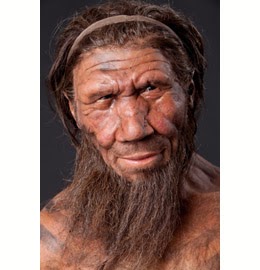
From 13 February to 28 September 2014 a new exhibit will be on show at the
Natural History Museum, London that highlights some of the (literally) ground-breaking research undertaken by scientists from St Andrews and elsewhere in the UK as part of the
Ancient Human Occupation of Britain project of the last 10 years.
Britain: One Million Years of the Human Story presents key material and evidence from a number of important sites in and around the UK that help to document the dramatic story of changing landscapes and the people who lived in them over the last million years. Two of the sites that this major exhibition showcases have been the focus of research for
Dr Richard Bates of the
Department of Earth & Environmental Sciences for the past 5 years. At
La Cotte de St Brelade in Jersey, high resolution marine mapping combined with geophysical modelling is allowing archaeologists to 'drain' away the sea and literally step back in time to walk through the ancient landscapes. The new views from the mammoth butchery cave site are providing alternate context for understanding the prolific finds that have been dug from the site over the last century. At
Happisburgh in Norfolk, geophysical surveys are not only revealing the hidden landscape but are also being used to target direct archaeological investigation. This is already showing dividends with new discoveries giving a unique perspective on the people who walked the ancient river shores over 800,000 years ago.
 |
| Mammoth butchery cave site at La Cotte de St Brelade in Jersey |
 From 13 February to 28 September 2014 a new exhibit will be on show at the Natural History Museum, London that highlights some of the (literally) ground-breaking research undertaken by scientists from St Andrews and elsewhere in the UK as part of the Ancient Human Occupation of Britain project of the last 10 years. Britain: One Million Years of the Human Story presents key material and evidence from a number of important sites in and around the UK that help to document the dramatic story of changing landscapes and the people who lived in them over the last million years. Two of the sites that this major exhibition showcases have been the focus of research for Dr Richard Bates of the Department of Earth & Environmental Sciences for the past 5 years. At La Cotte de St Brelade in Jersey, high resolution marine mapping combined with geophysical modelling is allowing archaeologists to 'drain' away the sea and literally step back in time to walk through the ancient landscapes. The new views from the mammoth butchery cave site are providing alternate context for understanding the prolific finds that have been dug from the site over the last century. At Happisburgh in Norfolk, geophysical surveys are not only revealing the hidden landscape but are also being used to target direct archaeological investigation. This is already showing dividends with new discoveries giving a unique perspective on the people who walked the ancient river shores over 800,000 years ago.
From 13 February to 28 September 2014 a new exhibit will be on show at the Natural History Museum, London that highlights some of the (literally) ground-breaking research undertaken by scientists from St Andrews and elsewhere in the UK as part of the Ancient Human Occupation of Britain project of the last 10 years. Britain: One Million Years of the Human Story presents key material and evidence from a number of important sites in and around the UK that help to document the dramatic story of changing landscapes and the people who lived in them over the last million years. Two of the sites that this major exhibition showcases have been the focus of research for Dr Richard Bates of the Department of Earth & Environmental Sciences for the past 5 years. At La Cotte de St Brelade in Jersey, high resolution marine mapping combined with geophysical modelling is allowing archaeologists to 'drain' away the sea and literally step back in time to walk through the ancient landscapes. The new views from the mammoth butchery cave site are providing alternate context for understanding the prolific finds that have been dug from the site over the last century. At Happisburgh in Norfolk, geophysical surveys are not only revealing the hidden landscape but are also being used to target direct archaeological investigation. This is already showing dividends with new discoveries giving a unique perspective on the people who walked the ancient river shores over 800,000 years ago. 